Kitchen Curds: I've Got your 180 Degrees Right Here
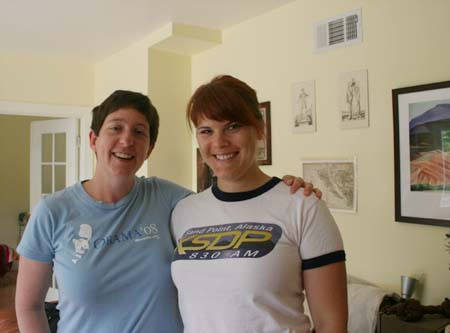 Three girls (Penny, Molly and Kirstin), two non-reactive pots, a book with misprinted temperature instructions, and a whole lotta curd love = a Kitchen Curd Party!
Three girls (Penny, Molly and Kirstin), two non-reactive pots, a book with misprinted temperature instructions, and a whole lotta curd love = a Kitchen Curd Party!
We met at noon, on a dark and stormy day. The eagle had landed, and she brought whole milk, citric acid, rennet, butter muslim, a thermometer, strainers, and snacks for sustenance until the cheese was ready. After nourishing ourselves with sparkling water spiked with peaches and lime and Blue Bottle coffee, we decided we were ready to start the Curding Process. It was time to heat up the milk.
Using the recipe from Kathy Farrell-Kingsley's Home Creamery book (pgs.84-86), we brought the milk to 88 degrees and added the citric acid. After the milk reached the prime temperature, we dissolved rennet in cool water and added the mix into the pot. 15 minutes later, we returned.
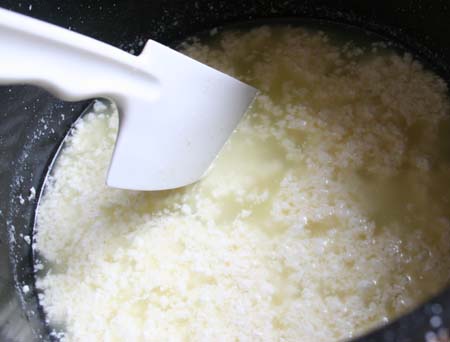
Back at the pot, curds were ready to greet us. Not the type that one could slice into one-inch sqaures like the Home Creamery book suggests, but curds just the same. No one was discriminating. They were little, they were real and we made them.
Next step - heating the curds to 108 degrees for 15 minutes, and stirring frequently. As the mixture rose in temperature, the whey slowly expelled, the curds became tighter and firmer, and Penny and I brought eight cups of salted water to 108 degrees in a separate pot while Molly cooked us fresh scallops (not in book, but highly recommended).
Penny and I took bringing those eight cups of water to 108 degrees very seriously . Between scallop bites, we took the water's temperature. A lot. Both of us. I think I even heard Penny assuring the water to come to the proper temperature only when it felt the moment was right, that we would wait just as long as it needed.
While the water was warming, we spooned the curds into a butter muslin-lined strainer. They were beautiful. After letting them sufficiently drain and cutting them, we placed them in a bowl, over which we prepared to pour the 108 degree water.
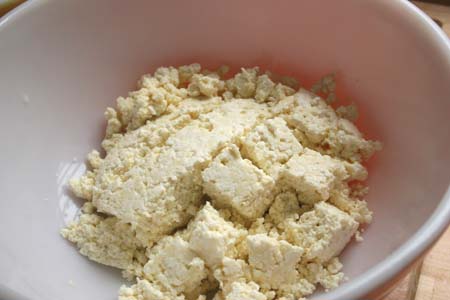
Then we added the water to the bowl to melt the curds.
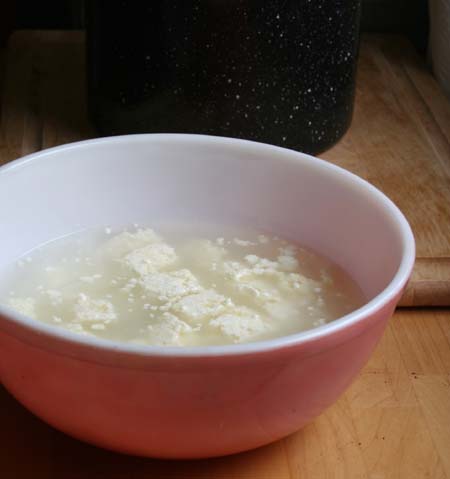
The girls told me I should be the first one to stretch the melted curds. Having heard before that only people with Italian blood running through their veins were allowed to stretch mozzarella, it was with wide eyes and a happy heart that I washed my hands, did a few lunges and neck rolls, and slipped my fingers in the bowl.
Instead of becoming a lovely lump, however, ready to be stretched into taffy-like submission, the curds separated. They fell apart in my fingers.
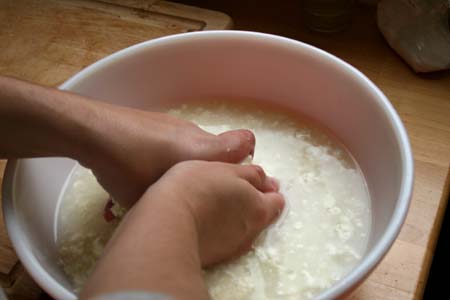
While Penny worked to convince me that it wasn't my Norwegian-American touch that caused the curds harm, Molly scanned the internet for what went wrong. We soon learned that, just like the twins in the Parent Trap, the "8" and the"0" had switched places. Unfortunately, this was in the part of the text that read "heat to 108 degrees." But there was still hope.
Next post: How to Fix Broken Curds: A Life Lesson.
Check out these other awesome Kitchen Curders who made mozzarella. Successfully. Anyone else who would like their link added to this post, please email it to me at itsnotyouitsbrie@gmail.com, or slip it in to the comment section below. Thank you for participating!
Girlichef made hers in the microwave in 30 minutes, and she stretched her curds magnificently.
Simona, at Bricole, made mozzarella two or three months before everyone else. That's skill.
* many pictures taken by Molly, the official "It's Not You, it's Brie" group and goat photographer.


